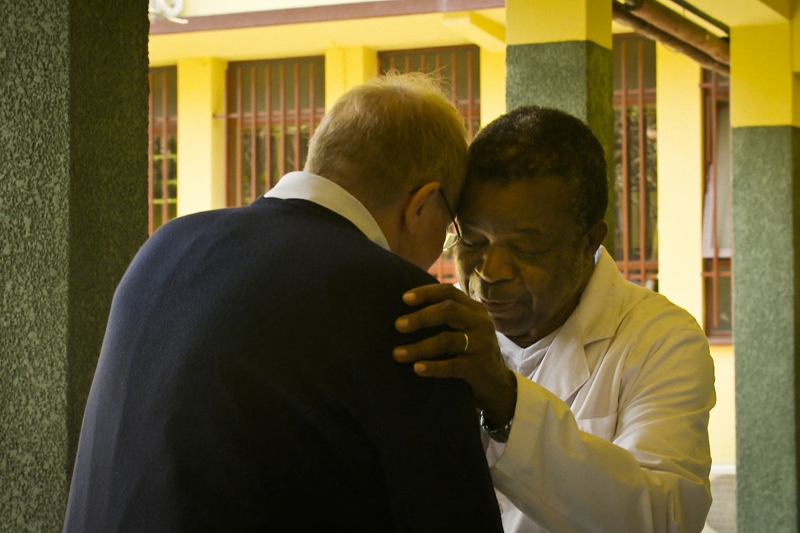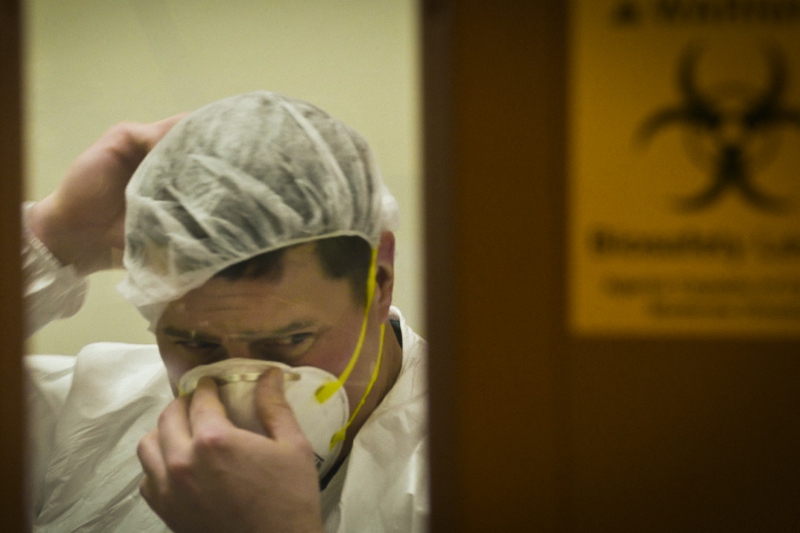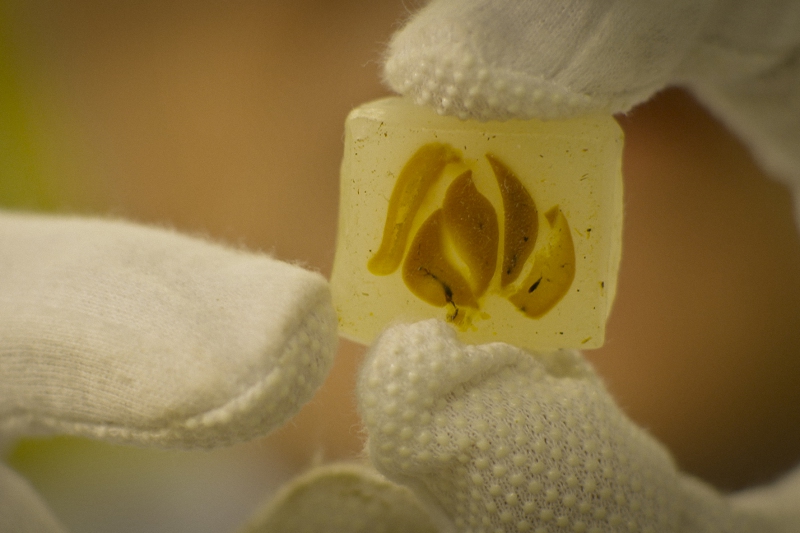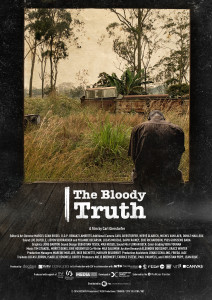The Bloody Truth
HIV is still the biggest viral killer worldwide: around 36 million people have died of AIDS, another 35 million live with the virus. Since HIV first appeared in gay communities on the west coast of the USA in the early 1980s, scientists have been wondering where this virus came from and how it found its way into 70 million people. After decades of research a stunning truth began to emerge: HIV has been with us for much longer than we think. It started to infect its first victims around one hundred years ago in a remote part of central Africa. It was the colonial opening up of that region which created opportunities for the virus to first jump into humans and then spread in its new host.
The world’s insatiable demand for rubber, timber and other raw materials uprooted hundreds of thousands of people; medical campaigns utilizing unsterile needles probably transferred the virus from one person to another. Sexually transmitted diseases, on which HIV hitchhikes, spread to epidemic proportions. Finally, transport networks along rivers and railroads doubled-up as highways along which HIV traveled from its jungle hideout into the world.
This film tells the story of the unknown pre-history of the AIDS virus, long before people started to die in the US and Europe. Following a team of scientists we uncover a forgotten medical archive in the Democratic Republic of Congo that tells of an epidemic a full two decades before anyone knew about the novel killer. From high-tech labs in the US to African medics who have their boots on the ground, we trace HIV back to its origin in the jungles of Cameroon. In the decades around the turn of the 20th century, colonialism fundamentally changed the lives of millions of people in central Africa; it created an environment that allowed HIV to leave its original host, the chimpanzee, and start to spread in humans.
But this film looks not only into the past. Today, more than ever, humans reach into the remotest corners of the planet in their thirst for raw materials. This brings thousands of people into intimate contact with pathogens that were never seen in humans before. The world today is much more inter-connected than it was a century ago. Add to this a collapsing health infrastructure in the hot-zones of viral transmission, and the threat of a new pandemic is perhaps larger than ever.
Apart from research into novel drugs and vaccines, our biggest weapon against these invisible killers is to know how they spread and why.
der Freitag: Dieser wie ein Krimi anmutende Film ist auch deshalb so aufstörend, weil die Parallelen zur heutigen Ebola-Epidemie in Westafrika so offensichtlich auf der Hand liegen.
teleschau – der mediendienst: Der Filmemacher belegt teils mit wissenschaftlichem, teils historischem Material, dass bereits Anfang der 1960er-Jahre eine Epidemie in Afrika gewütet hat. Doch Gierstorfers sehr analytische Zeitreise auf den Spuren des Virus reicht sogar bis in die Kolonialzeit des beginnenden 20. Jahrhunderts zurück.
Deutsche AIDS-Stiftung: Über Jahre begleitete der Biologe und Dokumentarfilmer Wissenschaftler auf ihrer Suche nach dem Ursprung des HI-Virus. Teils wissenschaftliche Reportage in von Kriegen und Korruption zerrütteten Ländern Afrikas, teils historische Analyse, eröffnet der Film eine völlig neue Perspektive auf die AIDS-Pandemie.
A film by Carl Gierstorfer
Camera: Renaat Lambeets
Sound: Luc Cuveele, Lieven Verbraeken
Editor & Art Director: Marcel Ozan Riedel
Music: Moritz Denis, Eike Hosenfeld, Tim Stanzel
Production Manager: Mareike Müller, Inge Rochette, Marilyn Belbenoit
Executive Producers: Antje Boehmert, Fabrice Estève, Paul Pauwels
Commissioning Editor for ZDF: Linde Dehner
Commissioning Editor for Smithsonian Channel: Charles Poe
Produced by DOCDAYS Productions, YUZU Productions and CONGOO Productions in co-production with Smithsonian Networks, ZDF in collaboration with ARTE, CCTV 10, RTBF, VRT, S4C. Produced with the support from Flanders Audiovisual Fund (VAF), MEDIA Programme of the European Union and The Pulitzer Center on Crisis Reporting. Distributed by PBS International.
Length: 52/48 min
Release Date: 2014
HIV is still the biggest viral killer worldwide: around 36 million people have died of AIDS, another 35 million live with the virus. Since HIV first appeared in gay communities on the west coast of the USA in the early 1980s, scientists have been wondering where this virus came from and how it found its way into 70 million people. After decades of research a stunning truth began to emerge: HIV has been with us for much longer than we think. It started to infect its first victims around one hundred years ago in a remote part of central Africa. It was the colonial opening up of that region which created opportunities for the virus to first jump into humans and then spread in its new host.
The world’s insatiable demand for rubber, timber and other raw materials uprooted hundreds of thousands of people; medical campaigns utilizing unsterile needles probably transferred the virus from one person to another. Sexually transmitted diseases, on which HIV hitchhikes, spread to epidemic proportions. Finally, transport networks along rivers and railroads doubled-up as highways along which HIV traveled from its jungle hideout into the world.
This film tells the story of the unknown pre-history of the AIDS virus, long before people started to die in the US and Europe. Following a team of scientists we uncover a forgotten medical archive in the Democratic Republic of Congo that tells of an epidemic a full two decades before anyone knew about the novel killer. From high-tech labs in the US to African medics who have their boots on the ground, we trace HIV back to its origin in the jungles of Cameroon. In the decades around the turn of the 20th century, colonialism fundamentally changed the lives of millions of people in central Africa; it created an environment that allowed HIV to leave its original host, the chimpanzee, and start to spread in humans.
But this film looks not only into the past. Today, more than ever, humans reach into the remotest corners of the planet in their thirst for raw materials. This brings thousands of people into intimate contact with pathogens that were never seen in humans before. The world today is much more inter-connected than it was a century ago. Add to this a collapsing health infrastructure in the hot-zones of viral transmission, and the threat of a new pandemic is perhaps larger than ever.
Apart from research into novel drugs and vaccines, our biggest weapon against these invisible killers is to know how they spread and why.
A Film by Carl Gierstorfer
Camera: Renaat Lambeets
Sound: Luc Cuveele, Lieven Verbraeken
Editor & Art Director: Marcel Ozan Riedel
Music: Moritz Denis, Eike Hosenfeld, Tim Stanzel
Production Manager: Mareike Müller, Inge Rochette, Marilyn Belbenoit
Executive Producers: Antje Boehmert, Fabrice Estève, Paul Pauwels
Commissioning Editor for ZDF: Linde Dehner
Commissioning Editor for Smithsonian Channel: Charles Poe
Produced by DOCDAYS Productions, YUZU Productions and CONGOO Productions in co-production with Smithsonian Networks, ZDF in collaboration with ARTE, CCTV 10, RTBF, VRT, S4C. Produced with the support from Flanders Audiovisual Fund (VAF), MEDIA Programme of the European Union and The Pulitzer Center on Crisis Reporting. Distributed by PBS International.
Length: 52/48 min
Release Date: 2014



